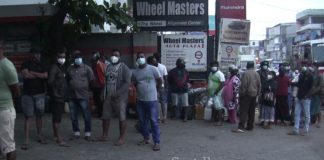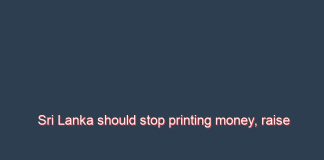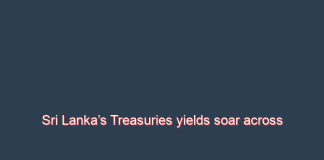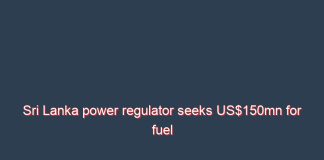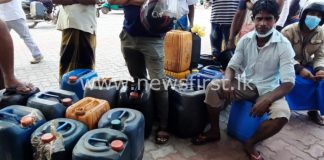Sri Lanka welcomes 96,000 tourists in Feb 2022 led by Russia
ECONOMYNEXT – Sri Lanka has welcomed 96,507 tourists in February 2022, up from 82,327 in January as the country re-opens for tourism, led by Russia, data from the state debt office showed.
Sri Lanka used to get over 200,000 tourists in February before the Coronavirus crisis.
In February Russia was the top generating market with 15,340 arrivals followed by India with 12,744, UK 10,642, Germany 7,740 and Ukraine 5,620.
In the first two months of the year, Russia brought 28,818 visitors and Ukraine 13,062 visitors. Russia’s invasion of Ukraine has put a damper on the flows.
“Ukraine and Russia conflict will be a big disaster as people will not travel, and Sri Lanka’s tourist market is largely European,” M Shanthikumar, President of the Hotel Association of Sri Lanka (THASL) told Economynext on February 25.
“There is no rush for Ukrainians to go back, as they feel much safer here,” he added.
Sri Lanka is extending visas for visitors from the country free of charge.
There were visa extensions and hotel bookings by the Ukrainians currently in the country.
In February 96,507 travellers had visited the country taking the total number of tourists to 178,834 in 2022.
Sri Lanka is targeting 1 million tourists in 2020 and is hoping to earn 2,000 million dollars.
From March 01 Sri Lanka scrapped pre-departure Coronavirus tests for inbound travellers with most of the population vaccinated and daily infections around 1000.
Other countries in the top 10 are France, Poland, Kazakhstan, Australia and Maldives. (Colombo/Mar03/2022)
Energy Ministry assures of fuel shipments; public seen queued up in...
Sri Lanka should stop printing money, raise interest rates, taxes: IMF
ECONOMYNEXT – Sri Lanka should stop printing money, raise rates and taxes to get out of the current crisis which may result in more monetary instability, the International Monetary Fund has said, after country cut taxes and engage record money printing to create a ‘production economy.’
The IMF staff after annual Article IV consultations (report not published) said there had been a large amount of “central bank direct financing of the budget,” an euphemism for printing money.
Sri Lanka printed 1.2 trillion rupees in 2021, in part due to reserve appropriations and price controls on bond yield that led to auction failures.
However after October 2021 money is printed to sterilize reserve sales for imports to maintain a 200 rupee to the US dollar peg as well as a quasi-fiscal activity involving giving subsidies through printed money to expatriate workers.
Inflation has started to soar after two years of money printing which sent broad money up 40 percent in the period.
“Directors agreed that a tighter monetary policy stance is needed to contain rising inflationary pressures, while phasing out the central bank’s direct financing of budget deficits,” the IMF’s executive directors concurring with a staff assessment said.
Sri Lanka started to print money extensively in February 2020 to keep interest rates down, after cutting taxes in December 2019, ostensibly to kick start a ‘production economy,’ based on post-Keynesian principles.
In March 2020 after a severe flexible exchange rate episode (a rapid shifting between pegged and floating regimes, with partial interventions that sends the rupee crashing down) a final downgrade cut off access to capital.
A downgrade came earlier after tax cuts in 2019 and also during a ‘flexible exchange rate’ episode in 2018. The downgrade via the flexible exchange rate and money printed to target an output gap came despite income and value added tax.
The IMF also urged tax hikes through both value added and income taxes.
IMF directors also called for the current 200 to the US dollar peg to be dropped in favour or a “gradual return to a market-determined and flexible exchange rate to facilitate external adjustment and rebuild international reserves.”
Analysts and classical economists have called for reforms to central bank’s governing law to block non-rule based (flexible) policy and commit the agency to a rule of law involving one monetary anchor.
One option is a clean floating rate (no reserve building, no interventions in fx market) with an inflation target (domestic anchor only) like most Western developed nations.
The second more simpler option is a consistent with reserve building and no policy rate (unsterilized interventions) with one external anchor, also known as a hard peg, like Hong Kong and some East Asian nations to stop trade controls, exchange controls, currency collapses, high inflation and social unrest.
A hard peg, which outlaws central bank financing of the budget, which led to the current crisis, is an automatic hard budget constraint.
Analysts have have pointed out that the ‘flexible exchange rate’ with dual anchors is a fancy name for the old Merecantilist, basket, band, crawl (BBC) inconsistent regime has resulted in severe trade and exchange controls.
IMF Concludes 2021 Article IV Consultation with Sri Lanka
Washington, DC – March 2, 2022: The Executive Board of the International Monetary Fund (IMF) concluded the Article IV consultation1 with Sri Lanka on February 25, 2022.
Sri Lanka has been hit hard by COVID-19. On the eve of the pandemic, the country was highly vulnerable to external shocks owing to inadequate external buffers and high risks to public debt sustainability, exacerbated by the Easter Sunday terrorist attacks in 2019 and major policy changes including large tax cuts at late 2019. Real GDP contracted by 3.6 percent in 2020, due to a loss of tourism receipts and necessary lockdown measures. Sri Lanka lost access to international sovereign bond market at the onset of the pandemic.
The authorities deployed a prompt and broad-based set of relief measures to cope with the impact of the pandemic, including macroeconomic policy stimulus, an increase in social safety net spending, and loan repayment moratoria for affected businesses. These measures were complemented by a strong vaccination drive. GDP growth is projected to have recovered to 3.6 percent in 2021, with mobility indicators largely back to their pre-pandemic levels and tourist arrivals starting to recover in late 2021.
Nonetheless, annual fiscal deficits exceeded 10 percent of GDP in 2020 and 2021, due to the pre-pandemic tax cuts, weak revenue performance in the wake of the pandemic, and expenditure measures to combat the pandemic. Limited availability of external financing for the government has resulted in a large amount of central bank direct financing of the budget. Public debt2 is projected to have risen from 94 percent of GDP in 2019 to 119 percent of GDP in 2021. Large foreign exchange (FX) debt service payments by the government and a wider current account deficit have led to a significant FX shortage in the economy. The official exchange rate has been effectively pegged to the U.S. dollar since April 2021.
The economic outlook is constrained by Sri Lanka’s debt overhang as well as persistently large fiscal and balance-of-payments financing needs. GDP growth is projected to be negatively affected by the impact of the FX shortage and macroeconomic imbalances on economic activities and business confidence. Inflation recently accelerated to 14 percent (y/y) in January 20223 and is projected to remain double-digit in the coming quarters, exceeding the target band of 4–6 percent, as strong inflationary pressures have built up from both supply and demand sides since mid-2021. Under current policies and the authorities’ commitment to preserve the tax cuts, fiscal deficit is projected to remain large over 2022–26, raising public debt further over the medium term. Due to persistent external debt service burden,
International reserves would remain inadequate, despite the authorities’ ongoing efforts to secure FX financing from external sources.
The outlook is subject to large uncertainties with risks tilted to the downside. Unless the fiscal and balance-of-payments financing needs are met, the country could experience significant contractions in imports and private credit growth, or monetary instability in case of further central bank financing of fiscal deficits. Additional downside risks include a COVID-19 resurgence, rising commodity prices, worse-than-expected agricultural production, a potential deterioration in banks’ asset quality, and extreme weather events. Upside risks include a faster-than-expected tourism recovery and stronger-than-projected FDI inflows.
Executive Board Assessment
Executive Directors commended the Sri Lankan authorities for the prompt policy response and successful vaccination drive, which have cushioned the impact of the pandemic. Despite the ongoing economic recovery, Directors noted that the country faces mounting challenges, including public debt that has risen to unsustainable levels, low international reserves, and persistently large financing needs in the coming years. Against this backdrop, they stressed the urgency of implementing a credible and coherent strategy to restore macroeconomic stability and debt sustainability, while protecting vulnerable groups and reducing poverty through strengthened, well-targeted social safety nets.
Directors emphasized the need for an ambitious fiscal consolidation that is based on high-quality revenue measures. Noting Sri Lanka’s low tax-to-GDP ratio, they saw scope for raising income tax and VAT rates and minimizing exemptions, complemented with revenue administration reform. Directors encouraged continued improvements to expenditure rationalization, budget formulation and execution, and the fiscal rule. They also encouraged the authorities to reform state-owned enterprises and adopt cost-recovery energy pricing.
Directors agreed that a tighter monetary policy stance is needed to contain rising inflationary pressures, while phasing out the central bank’s direct financing of budget deficits. They also recommended a gradual return to a market-determined and flexible exchange rate to facilitate external adjustment and rebuild international reserves. Directors called on the authorities to gradually unwind capital flow management measures as conditions permit.
Directors welcomed the policy actions that helped mitigate the impact of the pandemic on the financial sector. Noting financial stability risks from the public debt overhang and sovereign-bank nexus, they recommended close monitoring of underlying asset quality and identifying vulnerabilities through stress testing. Directors welcomed ongoing legislative reforms to strengthen the regulatory, supervisory, and resolution frameworks.
Directors called for renewed efforts on growth-enhancing structural reforms. They stressed the importance of increasing female labor force participation and reducing youth unemployment. Further efforts are needed to diversify the economy, phase out import restrictions, and improve the business and investment climate in general. Directors also called for a prudent management of the Colombo Port City project, and continued efforts to strengthen governance and fight corruption. They noted the country’s vulnerability to climate change and welcomed efforts to increase resilience.
Sri Lanka in drug shortages, due to price controls, forex crisis,...
ECONOMYNEXT – Sri Lanka’s price controls by the regulator compounded by a worsening forex crisis is creating shortages of drugs as importers found it difficult to open letters of credit and foreign principals declined to supply at controlled prices, industry officials said.
The Sri Lanka Chamber of Pharmaceuticals Industry says reluctance of banks to open letters of credit was making it difficult to import drugs, importers were exposed to currency risk from suppliers’ credit and of late fuel is being prioritized over drugs.
The National Medical Regulatory Authority was delaying registration and re-registration of drugs further contributing to supply disruptions in addition to price controls.
Price Controls
About 5 percent of drugs regulated with the National Medical Regulatory Authority were in short supply including paracetamol.
“There are around 7300 medicines registered with National Medicines Regulatory Authority and according to the retailers currently there is a shortage about 5 percent of those medicines in the market,” Sanjiva Wijesekera President of the Sri Lanka Chamber of Pharmaceuticals Industry said.
“The last increase of price was in August 2021 when the spot (US dollar) was at 194 rupees, but now it has increased up to 203 rupees.”
“So the suppliers are not willing to supply medicines for those prices.”
“Paracetamol, drugs for diabetes, high blood pressure, cholesterol are some of the medicines that are short in the market currently.”
NMRA was delaying in granting the re-registration of products which have been available in the market for a considerable period as well as new product registration, which is further delaying imports.
There has been criticism that the NMRA was creating monopolies in some drugs.
The NMRA was set up by the ousted Yahapalana administration to control prices and put more regulatory barriers between medicines and the people instead of restraining the central bank’s ability to print money to keep prices down.
Price control agency was set up according to a plan proposed by Senaka Bibile, a Marxist.
At the time analysts warned that it was a Marxist ‘social democrats’ style Weimar Republic move for which people will pay a heavy price.
Related
Sri Lanka’s pharma control Neros fiddling while Colombo burns with falling rupee
The SLCPI said ceiling prices should be raised because the exchange rate has depreciated, fuel costs are up, and interest costs were also rising.
The current administration in a progressive move removed price controls on most consumer goods, as shortages and black markets appeared but so far no action had been taken to remove price controls on drugs as the central bank printed money.
The regulator has also been given court orders to revisit the price controls but no action has been taken so far.
“We cannot change prices from consignment to consignment. Not having a price mechanism is one of the biggest issues we have,” Wijesekara said.
“We are not saying to get rid of the control price. We are asking to give us at least a temporary solution for this until a proper price mechanism take place.”
Forex shortages
Adrian Basnayake, the Past President and Council member of the SLCPI said, the commercial banks are refusing to issue letters of credit for the importers and asks the importers to buy dollar from exporters through at much higher price than the 203.
“If we take the lack of Paracetamol, it is not because the drug is not available. But according to the price we have, suppliers are not ready to give us,” Basnayake said. “It is similar for most medicines.”
Sri Lanka is facing a severe forex shortage due to money printed to enforce low interests rates after giving reserves for imports.
The country has a large budget deficit with salary hikes given to state workers in January needing higher interest rates. When money is printed to keep rates down, excess imports are triggered, creating forex shortages.
Commercial banks are reluctant to open letters of credit with no assurance that they can settle them on the stipulated date.
“When we go to banks to get dollar, there are no dollars to get,” Basnayake explained. “They say, if you can, go to exporters and get some dollars from them. When we contact them they agree to get give dollar not at 203 rupees but 245 rupees.”
Un-hedged Forex Risk
Importers have also brought drugs on supplier credit, and were exposed to forex risk if the rupee depreciated further.
“Let’s say we get to open a LC for 203 rupees,” Basnayake said. Usually we settle prices after around 3 months after importing the medicine. But if the Dollar rate has increased to 245 rupees within that three months, who has to bear that cost.”
“We do not have the capacity to cover that cost. Due to this, importer stop importing and that is another reason for the lack of medicine in the market. Considering all this, we are concerned about the future situation that can affect patients.”
Government Hospitals
SLCPI said the LC issue is affecting the medicine imports on government tenders as well.
“There is a delay in LC opening in government tenders as well,” M Prathabanthe, Senior Vice President of SLCPI said.
“Because of that there will be medicine shortage in government hospitals as well.”
Meanwhile people were stocking up on drugs adding to shortages.
“In the last 2-3 months our sales increased greatly,” Basnayake said. “We could have been happy about that but when our stocks are getting depleted and there are issues in importing, we realize the problem.”
Azam Jaward the Vice President, SLCPI said the industry has been de-prioritized to a certain extent due to the current power crisis where fuel is given priority.
“What coming is not good,” Jaward said. “Delays in NMRA, price control is causing a problem along with the dollar crisis.”
“Until last month we did not have any major issues. But now the banks have been advised to prioritize issuing LCs to import fuel. If this trend continues, even for the lifesaving drugs we will have a serious issue.
“We are at the moment have the supply for another 2-6 weeks, some medicines for another 3 months, but we are concern about the possible situations that can arise in the future in this country due to drug shortage.”
Latin America Soft-peg
Sri Lanka has a Latin America style central bank set up by a US money doctor, and inflation and currency depreciation has worsened since rule based policy was in favour of ‘flexible’ inflation targeting involving ‘data driven’ policy to target an output gap, which worsened to Modern Monetary Theory in 2020.
Now reserves are being given for imports and they are sterilized with new money.
“It is not possible to import goods freely when a soft-peg collapses because there will be forex shortages due to sterilized intervention,” EN Economic Columnist warned as far back as 2018 when highly discretionary policy was started.
“Import controls may also come.
As the cost of fuel or electricity goes up if prices are not raised, more money will be printed to subsidize energy, pushing the currency down.
“In Latin America, energy price controls have led to money printing and rationing. There can be power cuts and fuel shortages.
“In Sri Lanka because of price controls of the National Medicines Regulatory Authority medicines, drugs can go off the shelves.” (Colombo/Mar02/2022)
Sri Lanka’s Treasuries yields soar across maturities, one year up 142-bp
ECONOMYNEXT – Sri Lanka’s Treasury Bill yield rose across maturities with the one year yield up 142 points to 9.95 percent, in one of the biggest one day gains, data from the state debt office showed.
The 3-month yield rose 72 basis points to 9.33 percent.
The 6-month yield rose 135 basis points to 9.88 percent.
The debt office offered 55 billion rupees of bills and sold only 35 billion rupees.
The one year yield is still too low to draw interest and was sharply below inflation.
Sri Lanka’s inflation has been rising steeply to 13-year high after two years of money printing to keep interest rates down and the country is in a severe foreign exchange crisis.
Effective January 2022 the government also gave a billion US dollars worth of handouts.
There had been no increase in fuel prices as global prices rose.
The central bank has called for market pricing of fuel to stop further credit from banks to state-run Ceylon Petroleum Corporation.
Sri Lanka chamber calls for urgent end to power, forex crisis,...
ECONOMYNEXT – Sri Lanka’s Ceylon Chamber of Commerce called for an urgent end to the foreign exchange crisis which was leading to hurting industry and tourism.
“The Chamber is of the view that these issues are all ramifications of the shortage of foreign exchange experienced by the country and believes urgently addressing the currency issue is the fastest way in which the power and energy issues can be tackled in the short term,” the Ceylon Chamber said.
“As a first step in this direction, the Ceylon Chamber of Commerce urges the Government of Sri Lanka to commence a process of engagement with the International Monetary Fund (IMF) without any further delay to obtain their technical advice in managing the debt servicing as well as boosting foreign reserves.”
The IMF completely halts the us of foreign reserves (savings) for imports through a float of the currency and stops a country from living beyond its means using accumulated reserves of the past.
Instead interest rates are raised to slow domestic credit and reserves are collected as private credit and consumption slows. Breaks are also put on state spending.
An IMF program usually only allows reserves to be used in extreme cases (under a disorderly market conditions or DMC rule) for trade transactions, sometimes under a non-sterilized rule which makes rates go up.
Instead IMF forces a central bank, after a float to buy dollars and raise Net International Reserves through an NIR target by re-pegging at a different rate. Reserves however are allowed to be used for debt repayment through a continuous performance criterion on non-accumulation of external arrears.
An IMF program will may involve debt – restructuring, when a country is cut off from capital markets.
The full statement is reproduced below:
Ceylon Chamber seeks urgent action to restore electricity and fuel supply to avoid a standstill in economic activity
The Ceylon Chamber of Commerce notes with serious concern the adverse effects brought on its members and all sectors of the economy in general as a result of the ongoing interruptions to the supply of electricity coupledwith frequent disruptions to the availability of fuel.
The Chamber is of the view that these issues are all ramifications of the shortage of foreign exchange experienced by the country and believes urgently addressing the currency issue is the fastest way in which the power and energy issues can be tackled in the short term. CCC will also soon provide further recommendations on what other actions are needed specifically on power and energy sectors in the medium to long term in consultation with relevant experts.
As a first step in this direction, the Ceylon Chamber of Commerce urges the Government of Sri Lanka to commence a process of engagement with the International Monetary Fund (IMF) without any further delay to obtain their technical advice in managing the debt servicing as well as boosting foreign reserves.
The Chamber hopes that this engagement should result in a Debt Sustainability Analysis being carried out by the IMF which could pave the way for a pre-emptive debt restructuring programme.
It is the Chamber’s belief that a systematic and methodical approach to restructure debt with the support of the IMF will help the Government to successfully manage its external debt obligations while ensuring the availability of much needed foreign exchange to support vital economic activity.
This could ensure the allocation of scarce foreign exchange reserves towards the purchase of essential supplies such as fuel for electricity generation, transport of goods and persons and other industrial purposes without holding it back for debt servicing.
The Chamber is concerned that the recovery seen recently in tourism and export sectors can be seriously hampered and economic growthslowed down unless urgent action is taken to eliminate the disruptions to the supply of electricity and fuel which is threatening to cripple all sectors of the economy.
The Ceylon Chamber of Commerce, on its own and together with other chambers, has,on numerous occasions, consistently advocated an engagement with IMF since the beginning of the Covid-19 pandemic in March 2020.
Chinese envoy meets Sri Lanka leader, discusses Belt and Road projects
ECONOMYNEXT – Chinese Ambassador to Sri Lanka Qi Zhenhong met Sri Lankan President Gotabaya Rajapaksa on Monday (28) and discussed bilateral and diplomatic relations including Belt and Road projects, the Chinese embassy in Colombo said.
The meeting comes weeks after India pledged to assist Sri Lanka with much needed financial assistance including a 400 million US dollar swap arrangement, a 500 million US dollar credit line to purchase fuel with, and a 1 billion US dollar credit line to buy essential foods and medicines.
Both Sri Lanka and China are celebrating the 65th anniversary of diplomatic relations as well as the 70th anniversary of the historic rubber-rice pact signed between the two countries.
“Zhenhong emphasised that the biggest inspiration from the 65th anniversary of the establishment of diplomatic relations between China and Sri Lanka is that no matter how the domestic and international situation changes in Sri Lanka in the past, present or future, China will always be Sri Lanka’s most trustworthy good friend, true friend and old friend (sp),” the Chinese embassy said in a statement.
“The current world situation is changing rapidly, and the spirit of the rubber-rice pact of ‘independence, self-reliance, unity and mutual support’ is even more significant today, 70 years later. At the new historical starting point, China is willing to join hands with Sri Lanka to make unremitting efforts to improve the quality and upgrade of bilateral relations.”
According to the statement, the two sides also conducted friendly and in-depth exchanges on topics such as economic, trade and financial cooperation between the two countries, major “Belt and Road” projects, and regional cooperation.
Sri Lanka has been in the middle of a geopolitical tussle between China, the US and India, analysts say.
China has invested in and loaned billions of dollars for Sri Lanka’s post-war infrastructure and also owns the country’s largest port in the southern district of Hambantota and reclaimed land worth 1.5 billion US dollars next to the island nation’s main port in Colombo.
The Chinese embassy statement further said President Rajapaksa discussed Sri Lanka’s current economic and financial situation and thanked China for its long-term and firm support for Sri Lanka’s national development. The president said he looked forward to further strengthening cooperation with China to bring more benefits to the two nations.
The president’s office confirmed the meeting with the Chinese Ambassador but did not reveal any details.
Sri Lanka is facing a financial and dollar crisis with the country running out dollars to buy fuel, essential foods, and gas.
Lack of fuel imports due to the dollar shortage has already resulted in extended power cuts and long queues for fuel. (Colombo/Mar02/2022)
Sri Lanka power regulator seeks US$150mn for fuel for 60-days
ECONOMYNEXT – Sri Lanka’s power regulator said it has sought 150 million US dollars from the central bank to import fuel for the next two months, but no response has been received forcing power cuts of over seven hours from March 02.
The Public Utilities Commission of Sri Lanka said President Gotabaya Rajapaksa had also instructed the central bank to provide the necessary foreign exchange but it had not happened.
“We have given a number of proposals to the government and cabinet to solve the power crises but the advice not been taken in to consideration,” PUCSL Chairman Janaka Ratnayake said in a statement.
“The power crisis that has come from the fuel crisis is due to the wrong financial management. That is to say, unwise use of foreign exchange. Priority should be given for fuel.
PUCSL had also advised that the Ceylon Electricity Board and Independent Power Producers be allowed to import fuel directly.
“The power plants need 150 million US dollars in the next two months to buy diesel, naptha and furnace oil,” Ratnayake said.
“We ask relevant parties that our proposals be followed.”
“Due to the 7 to 8 hour power cut, small and large industries will become inactive. It will make the entire economy fall.”
Sri Lanka is facing severe foreign exchange shortages due to liquidity injections made to enforce low interest rates. (Colombo/Mar02/2022)
Sri Lanka to lose power for seven-and-a-half hours on March 02...
ECONOMYNEXT – Sri Lanka will see an unprecedented seven-hour scheduled power outage on Wednesday (02), with some areas expected to lose electricity for seven hours and 30 minutes.
The Public Utilities Commission of Sri Lanka (PUCSL) confirmed the decision to reporters Tuesday (01) afternoon.
Click here for the demand shedding schedule for Wednesday (02).
The island nation is in the midst of a power crisis on top of a severe forex shortage as the Ceylon Electricity Board (CEB) struggles to find fuel for thermal power generation, even as the reservoirs used for hydro power generation continue to run dry. On February 15, the CEB sought PUCSL permission for daily scheduled power cuts until further notice to provide electricity to meet peak demand during the day and at night.
On Tuesday, the CEB announced a three-hour power cut during day time and a possible 30-minute cut at night.
Even though the Central Bank of Sri Lanka (CBSL) has issued dollars for the Ceylon Petroleum Corporation (CPC) to pay for diesel off a ship that arrived last weekend, authorities have said it will not be sufficient to run the country’s thermal plants continuously.
The CEB said that, due to the unavailability of fuel, several thermal plants have been forced to shut down, while the MahaWeli Authority has instructed the utility provider to limit the drawdown of Castlereigh, Mausakelle and Samanalawewa reservoirs which are used for hydro power generation.
According to Wednesday’s power cut schedule, E and F areas will have outages of five hours each between 8am and 6pm and two hours power cuts between 6pm and 11pm.
In P, Q, R, S, T, U, V and W areas, power cuts of five hours will be imposed between 8am and 6pm and two hours and 30 minutes between 6pm and 11pm.
“If we can’t get credit from banks, if the government is not giving us any relief and if we also cannot increase prices, tell me where to find money to bring in diesel,” Energy Minister Udaya Gammanpila told the privately owned Derana Tv on Tuesday (01).
“We have 20,000 metric tonnes of diesel in stock, enough for four days. There is another ship coming tomorrow.”
Gammapila said the government should understand priorities when importing products into the country.
“Our imports bill for the last year was one of the biggest [on record], which was 21 billion US dollars. Only 2.8 billion dollars was spent on fuel,” he said.
“According to CBSL, we have spent 6 billion US dollars for non-essential items such as drinking water, dhal, apple, and other fruits. Their reason for importing these items such as fruits is that tourists are demanding these items. But if tourists come and they have to stay in the dark with no electricity, or can’t travel because of fuel shortages, they will not visit Sri Lanka again. So we have to identify the priorities. This is a more crucial situation than the war we faced in the past,” the minister said. (Colombo/Mar01/2022)

